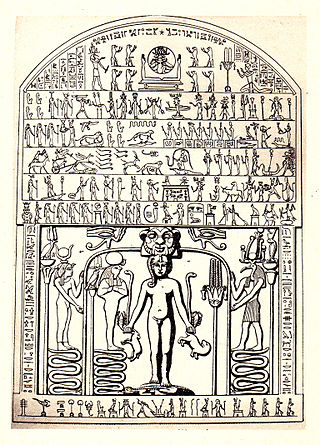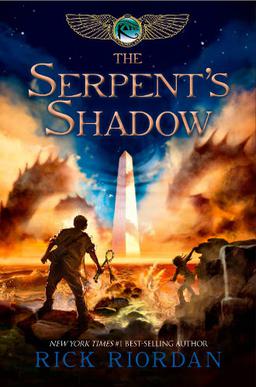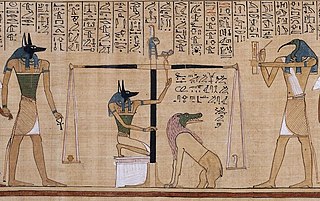Related Research Articles

The Osiris myth is the most elaborate and influential story in ancient Egyptian mythology. It concerns the murder of the god Osiris, a primeval king of Egypt, and its consequences. Osiris's murderer, his brother Set, usurps his throne. Meanwhile, Osiris's wife Isis restores her husband's body, allowing him to posthumously conceive their son, Horus. The remainder of the story focuses on Horus, the product of the union of Isis and Osiris, who is at first a vulnerable child protected by his mother and then becomes Set's rival for the throne. Their often violent conflict ends with Horus's triumph, which restores maat to Egypt after Set's unrighteous reign and completes the process of Osiris's resurrection.

Set is a god of deserts, storms, disorder, violence, and foreigners in ancient Egyptian religion. In Ancient Greek, the god's name is given as Sēth (Σήθ). Set had a positive role where he accompanies Ra on his barque to repel Apep, the serpent of Chaos. Set had a vital role as a reconciled combatant. He was lord of the Red Land (desert), where he was the balance to Horus' role as lord of the Black Land.

The Duat is the underworld in ancient Egyptian mythology. It has been represented in hieroglyphs as a star-in-circle: 𓇽. The god Osiris was believed to be the lord of the underworld. He was the first mummy as depicted in the Osiris myth and he personified rebirth and life after death. The underworld was also the residence of various other gods along with Osiris.

Nehebkau was the primordial snake god in ancient Egyptian mythology. Although originally considered an evil spirit, he later functions as a funerary god associated with the afterlife. As one of the forty-two assessors of Ma’at, Nehebkau was believed to judge the deceased after death and provide their souls with ka – the part of the soul that distinguished the living from the dead.

Senet or senat is a board game from ancient Egypt that consists of 10 or more pawns on a 30 square playing board. The earliest representation of senet is dated to c. 2620 BCE from the Mastaba of Hesy-Re, while similar boards and hieroglyphic signs are found even earlier, including in the Levant in the Early Bronze Age II period. Even though the game has a 2000-year history in Egypt, there appears to be very little variation in terms of key components. This can be determined by studying the various senet boards that have been found by archaeologists, as well depictions of senet being played throughout Egyptian history on places like tomb walls and papyrus scrolls. However, the game fell out of use following the Roman period, and its original rules are the subject of conjecture.
Book of Thoth is a name given to many ancient Egyptian texts supposed to have been written by Thoth, the Egyptian god of writing and knowledge. They include many texts that were claimed to exist by ancient authors and a magical book that appears in an Egyptian work of fiction.

"The Sorcerer's Apprentice" is a poem by Johann Wolfgang von Goethe written in 1797. The poem is a ballad in 14 stanzas.

The Coffin Texts are a collection of ancient Egyptian funerary spells written on coffins beginning in the First Intermediate Period. They are partially derived from the earlier Pyramid Texts, reserved for royal use only, but contain substantial new material related to everyday desires, indicating a new target audience of common people. Coffin texts are dated back to 2100 BCE. Ordinary Egyptians who could afford a coffin had access to these funerary spells and the pharaoh no longer had exclusive rights to an afterlife.

QV44 is one of several tombs located in the Valley of the Queens intended for the use of Ramesses III's sons. The painted reliefs decorating Khaemwaset E's tomb illustrate his ritual and symbolic journey in the Afterlife as he meets the main gods of that region as well as the genies who guard the gates of the kingdom of Osiris.
Prince Khaemweset was the fourth son of Ramesses II and the second son by his queen Isetnofret. His contributions to Egyptian society were remembered for centuries after his death. Khaemweset has been described as "the first Egyptologist" due to his efforts in identifying and restoring historic buildings, tombs and temples.

The Metternich Stela is a magico-medical Horus on the Crocodiles stele that is part of the Egyptian Collection of the Metropolitan Museum of Art in New York City. It dates to the Thirtieth Dynasty of Egypt around 380–342 B.C. during the reign of Nectanebo II. The provenance of the stele is unknown.
Certain numbers were considered sacred, holy, or magical by the ancient Egyptians, particularly 2, 3, 4, 7, and their multiples and sums.

The Greek Magical Papyri is the name given by scholars to a body of papyri from Graeco-Roman Egypt, written mostly in ancient Greek, which each contain a number of magical spells, formulae, hymns, and rituals. The materials in the papyri date from the 100s BCE to the 400s CE. The manuscripts came to light through the antiquities trade, from the 1700s onward. One of the best known of these texts is the Mithras Liturgy.

The Serpent's Shadow is a 2012 fantasy adventure novel based on Egyptian mythology written by American author Rick Riordan. It is the third and final novel in The Kane Chronicles series. It was published by Disney Hyperion on May 1, 2012.

The Crown of Ptolemy is the third and last book in the Percy Jackson and the Olympians and The Kane Chronicles crossover series. It was released in the back of the paperback version of The House of Hades on March 31, 2015, and later as an ebook and audiobook. The ebook edition was released May 12, 2015.
"The Quarrel of Apophis and Seqenenre" is an ancient Egyptian story. It is fragmentarily attested only in a papyrus copy made by a scribe named Pentawer during the reign of pharaoh Merenptah of the 19th Dynasty. The story is set in an earlier date, towards the end of the Second Intermediate Period: the main characters are the two pharaohs Apophis and Seqenenre Tao, though the text is not historically accurate. In it, 'the Hyksos king Apophis challenges Seqenre, the local ruler of Thebes, with an adynaton [puzzle]. The end of the tale has been lost, but Seqenenre presumably found a solution, perhaps with the help of a wise counsellor.' It is part of a wider corpus of ancient Egyptian tales of wisdom-contests: it has some similarities, for example, to the much later "Tale of Setne Khamwas and Si-Osire", attested on papyrus in the Roman period.
Riddle-tales are traditional stories featuring riddle-contests. They frequently provide the context for the preservation of ancient riddles for posterity, and as such have both been studied as a narrative form in their own right, and for the riddles they contain. Such contests are a subset of wisdom contests more generally. They tend to fall into two groups: testing the wisdom of a king or other aristocrat; and testing the suitability of a suitor. Correspondingly, the Aarne–Thompson classification systems catalogue two main folktale-types including riddle-contests: AT 927, Outriddling the Judge, and AT 851, The Princess Who Can Not Solve the Riddle. Such stories invariably include answers to the riddles posed: 'the audience cannot be left dangling'.

Ancient Egyptian afterlife beliefs were centered around a variety of complex rituals that were influenced by many aspects of Egyptian culture. Religion was a major contributor, since it was an important social practice that bound all Egyptians together. For instance, many of the Egyptian gods played roles in guiding the souls of the dead through the afterlife. With the evolution of writing, religious ideals were recorded and quickly spread throughout the Egyptian community. The solidification and commencement of these doctrines were formed in the creation of afterlife texts which illustrated and explained what the dead would need to know in order to complete the journey safely.

The Cavern deities of the underworld were ancient Egyptian minor deities charged with punishing the damned souls by beheading and devouring them.
References
- ↑ Konstantakos 2004, p. 90
- ↑ Lipinski, Edward (2010-07-07). "Hiram of Tyre and Solomon". The Books of Kings. pp. 251–272. doi:10.1163/ej.9789004177291.i-712.45. ISBN 9789047430735.
- 1 2 Lichtheim, Miriam, Ancient Egyptian Literature, Volume III: The Late Period, University of California Press, 2006 [1980], pp. 138–151.
- ↑ Konstantakos 2004, p. 115
- ↑ Bauckham, Richard B. (1998). The Fate of the Dead: Studies on the Jewish and Christian Apocalypses. Brill Publishing. p. 97–103. ISBN 90-04-11203-0.
- ↑ Ehrman, Bart (2020). Heaven and Hell: A History of the Afterlife. Simon & Schuster. p. 223-226. ISBN 978-1501136733.
Bibliography
- Ioannis M. Konstantakos, 'Trial by Riddle: The Testing of the Counsellor and the Contest of Kings in the Legend of Amasis and Bias', Classica et Mediaevalia, 55 (2004), 85-137